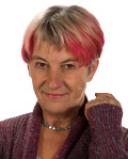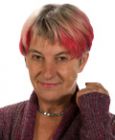Parapsychology
Out-of-Body Experiences: More Full Body Illusions
Part 12. Losing the sense of where I am.
Posted September 16, 2019
In my previous post I compared OBEs with autoscopy. This is the, usually pathological, experience of seeing a double of oneself, like a Doppelgänger. But there are even odder experiences of self-separation, including another "full-body illusion" known as "heautoscopy".
Heautoscopy must be the hardest to imagine. As in OBEs or autoscopy, patients see a double, but they may be unsure which is which—me or my double. They may feel they are in both places at once or be unsure which one is ‘me’ or which position they are looking from. Both body and self seem to be duplicated and sometimes perception flips between the two positions. This means that both self-localization and first-person perspective are disrupted, and even the sense of self-identification may seem to be “split in two parts” (Furlanetto et al 2013). This sounds most unpleasant, and indeed some people experiencing heautoscopy can be so distressed that they may even resort to suicide (Brugger et al 1994).
One patient felt as if she were "standing at the foot of my bed and looking down at myself." Asked at which of these two positions she thinks herself to be, she answered that "I am at both positions at the same time" (Blanke et al 2004).
Another patient, a forty-year-old Italian woman with an epileptic focus in the right parietal lobe used to see the image of her entire body as in a mirror or from an external point of view. She saw herself not from an elevated visuo-spatial perspective, as in out of body experience, but in front of her in normal size and color without a definable facial expression. The patient could not clearly define her localization in space. (Anzellotti et al 2011)
When I first read about these odd experiences, I assumed heautoscopy was quite a separate phenomenon from the OBE. But now I’m not so sure.
I am currently reading Michael Graziano’s latest book Rethinking Consciousness—a terrific book I will write about later. What is so relevant here is his detailed descriptions of how the body schema functions and the central role of the TPJ (that spot which can induce OBEs when stimulated) in constructing our sense of self. It is the TPJ, with its multiple connections to attention systems, that gives us the sense of being in a body at a specific location. So what happens during heautoscopy and OBEs?

I had been simplistically assuming that in an OBE the felt location is entirely outside the body, but according to OBE researcher Jason Braithwaite, many people having OBEs report still having a sense of where their physical body is and what it’s doing. Thinking back to my own OBE I realize that in the early stages I was still well aware of my physical body. I was looking at it as though from outside but had no doubt that that was ‘my body’ and I could feel its movements. Only, later on, did that sense entirely disappear and my total experience was of disembodiment. This transition suggests a closer relationship between OBEs and heautoscopy than I had imagined. Another odd fact adds more.
Even rarer than the kind of heautoscopy I have already described are the bizarre phenomena of "negative heautoscopy" and "internal heautoscopy". In negative heautoscopy, people report failing to see their own bodies. They can look down and fail to see their own legs. They may even look into a mirror and see no one there.
Internal heautoscopy means that people claim to be seeing inside their own body, sometimes seeing one or more inner organs (Brugger and Mohr 2005). This was originally reported in the early days of hypnosis and it seems that the organs people "saw" were not anatomically plausible. Brugger gives a vivid example which he translated from a 1920s account of a healthy man who suffered a severe attack of vertigo.
I approached myself, or rather my body which I already considered dead. A scene which I did not grasp immediately attracted my attention: I saw myself breathing and then I saw the interior of my torso, saw my heart slowly and regularly beating there. I saw the blood circulating in the vessels. (Brugger et al 1997 p 27)
You might be thinking that this is totally irrelevant to OBEs, and I would have thought the same had I not experienced this myself. After nearly two hours into my own OBE, when I was trying to return to my body, I found myself going in through what seemed to be my own neck but with a jagged edge. By that late stage everything had become distinctly weird! What happened next, I described as follows:
It was all varying shades of brown, a little greenish in some places and shaded almost like a drawing … it appeared to have no contents whatever, to be just a hollow shell. I went down one of the legs, balanced on the knee joint and then, as if under the influence of gravity, whizzed down the leg into the foot, like going down a slide … There I could look into any one of the openings made by the toes and see light streaming in through the window-like toenails. (Blackmore 2017 p 140 and online).
For me, what had begun as a classic OBE, gently leaving my body and seeming to fly above it, had turned into what a psychiatrist might call internal heautoscopy. The odd thing is that it seemed absolutely clear, vivid and realistic. At the time I thought my soul had separated from its body and then gone exploring inside. It was that realistic.
There is just one more full-body illusion to consider and I’ll turn to that next—the ghostly sense of an invisible presence.
References
Anzellotti, F., Onofrj, V., ... & Onofrj, M. (2011). Autoscopic phenomena: case report and review of literature. Behavioral and Brain Functions, 7(1), 2.
Blackmore, S. 2017 Seeing Myself: The new science of out-of-body experiences, London, Robinson
Blanke, O., Landis, T., Spinelli, L., & Seeck, M. 2004. Out‐of‐body experience and autoscopy of neurological origin. Brain, 127:2, 243-258
Blanke, O., & Mohr, C. 2005. Out-of-body experience, heautoscopy, and autoscopic hallucination of neurological origin: Implications for neurocognitive mechanisms of corporeal awareness and self-consciousness. Brain Research Reviews, 50(1), 184-199
Brugger, P., Agosti, R., Regard, M., Wieser, H., and Landis, T. 1994. Heautoscopy, epilepsy and suicide. J. Neurol. Neurosurg. Psychiatry 57, 838–839
Brugger, P., Regard, M., & Landis, T. 1997. Illusory reduplication of one's own body: phenomenology and classification of autoscopic phenomena. Cognitive Neuropsychiatry, 2(1), 19-38
Furlanetto, T., Bertone, C., & Becchio, C. 2013. The bilocated mind: new perspectives on self-localization and self-identification. Frontiers in human neuroscience, 7, 71
Graziano, M. 2019 Rethinking Consciousness: A scientific theory of subjective experience. New York, Norton.




